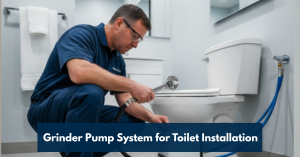If you’ve noticed your hot water running out faster than usual or your water heater making odd popping noises, it might be time for a little maintenance. One of the most important things you can do for your water heater is to drain it and remove sediment buildup.
At Whitney Services, we help homeowners in Pennfield keep their plumbing running smoothly. Whether you’re curious about how to drain water heater in Pennfield or you’re thinking about a full water heater installation, this guide will walk you through everything you need to know, step by step, safely and easily.
Key Takeaways
- Regularly draining your water heater helps prevent sediment buildup and keeps your unit running efficiently.
- Draining a water heater can be a DIY task, but having plumbing services in Pennfield handle it ensures a safe, thorough job.
- A professional plumber can also inspect your tank for signs of wear and discuss whether a water heater installation in Pennfield might be a smarter long-term choice.
Why Draining Your Water Heater Matters
Over time, minerals and debris from your home’s water supply settle at the bottom of your water heater tank. This sediment buildup creates a barrier between the heating element and the water, forcing your unit to work harder and use more energy to produce hot water. You may even hear rumbling or popping sounds, signs that sediment is boiling inside your tank.
By regularly draining your water heater, you can extend its lifespan, improve efficiency, and avoid costly repairs. For Pennfield homeowners, where mineral content in water can vary, flushing your water heater once or twice a year can make a big difference in how well your plumbing performs.
How to Drain Your Water Heater in Pennfield – Step-by-Step Guide
Draining a water heater might sound complicated, but with a few simple tools and safety precautions, it’s easier than you think. Here’s how to do it right.
1. Turn Off the Power or Gas Supply
Turn off the electricity at the breaker box if you have an electric water heater. For gas units, switch the thermostat to “pilot” or “off.” Let the water cool down for about 30 minutes before you begin. Safety first!
2. Turn Off the Cold Water Supply
Locate the cold water valve on top of your water heater and turn it clockwise to stop new water from flowing into the tank.
3. Connect a Hose to the Drain Valve
Attach a garden hose to the drain valve located near the bottom of your tank. Run the other end of the hose to a floor drain, sump pit, or outside where it can safely release hot water.
4. Open a Hot Water Faucet
Turn on a hot water tap somewhere in your home, such as a sink or bathtub. This allows air to enter the system and helps the water drain more smoothly from the tank.
5. Open the Drain Valve
Carefully open the drain valve to let the water flow out. Be cautious, if you haven’t allowed the tank to cool long enough, the water will be hot. You might notice cloudy or rust-colored water at first, which is normal as sediment is flushed out.
6. Flush the Tank
Once the water has mostly drained, turn the cold water supply back on for a few seconds to stir up and flush any remaining sediment from the bottom of the tank. Repeat this until the water runs clear.
7. Close the Valve and Refill the Tank
After flushing, close the drain valve tightly and remove the hose. To replenish the tank, turn on the cold water supply again. When the tank is full and you’ve ensured there are no leaks, turn the power or gas back on.
That’s it! You’ve successfully drained your water heater. Your system should now run more efficiently and quietly.
When to Call a Professional
While draining your water heater is a fairly simple task, not every situation is the same. If the drain valve is stuck, the sediment is extremely thick, or you’re just not comfortable handling plumbing tools, it’s best to reach out to a professional.
Our plumbing services in Pennfield can handle the process quickly and safely. We also inspect your water heater for any signs of corrosion, leaks, or inefficiencies that could turn into bigger problems down the road.
Why Choose Whitney Services
At Whitney Services, we take pride in helping Pennfield homeowners care for their homes with honest, professional service. Whether it’s routine maintenance, a repair, or a new water heater installation, we treat every job with the same attention and respect we’d want for our own homes.
Here’s why local homeowners trust us:
Expert Local Knowledge
We understand Pennfield’s water conditions and know how to protect your plumbing system.
Full-Service Plumbing
From small leaks to full plumbing services and installations, we do it all.
Quality Workmanship
Our experienced team ensures each project meets the highest safety and quality standards.
Friendly, Transparent Service
We explain what we’re doing, why it matters, and what you can expect—no surprises.
If you’d prefer a helping hand instead of a DIY session, we’re just one call away. Visit Whitney Services or give us a call today to schedule your water heater service.
Conclusion
Taking the time to drain your water heater is one of the best ways to keep it performing at its best. With regular maintenance, you’ll enjoy cleaner water, lower energy bills, and a system that lasts longer.
Whether you decide to handle it yourself or call in the pros, Whitney Services is here to help with expert plumbing services in Pennfield and dependable water heater installation when the time comes. A little care goes a long way toward keeping your home’s plumbing running like new.
Frequently Asked Questions
Once a year is generally enough, though homes with hard water may benefit from draining it every six months.
If you’re comfortable working with valves and hoses, you can do it yourself. But if your tank hasn’t been serviced in years, it’s wise to call a professional plumber in Pennfield.
Sediment buildup can block the valve. A professional plumber can safely clear the blockage or replace the valve without damaging the tank.
If your water heater is more than ten years old, has frequent leaks, or doesn’t heat water properly, it may be time for a new water heater installation in Pennfield.
Sediment will continue to build up, reducing efficiency and potentially causing damage to the tank and heating elements. Regular draining helps avoid those costly issues.







